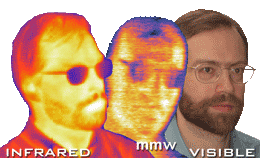
home | Who are we? | Workshop | Resources | Links | Gallery |
| Infrared Camera |
The world appears quite different when you look at it with wavelengths of light beyond the ‘visible’ part of the spectrum which we see with our eyes. To do this requires cameras which collect the non-visible wavelengths turning them into pictures which we can see. This image is coming directly from the infrared camera and actually shows heat emitted from your body. The coloured bar on the right shows how the colours in the image correspond to temperature. Hair appears cold since it is insulating and doesn’t let heat escape from your head. Your nose and ears are usually the coldest part of your head whereas your eyes are generally the hottest part. Although visible light (light that our eyes see) can go through
glass, infrared light can't and that is why glasses look black. |
'Vision For The Future' is an EPSRC funded project run by the MMW group at the University of St Andrews
Copyright ©2006 by the University of St Andrews :: web, graphic and exhibition design by FifeX Ltd, www.fifex.co.uk
 This
infrared camera records light with wavelengths around one ten-millionth
of a metre which is about twenty times longer than visible light.
A millimetre wave camera can also show heat but in a slightly different
way since the wavelengths are a further 300 times longer than those
collected by the infrared camera.
This
infrared camera records light with wavelengths around one ten-millionth
of a metre which is about twenty times longer than visible light.
A millimetre wave camera can also show heat but in a slightly different
way since the wavelengths are a further 300 times longer than those
collected by the infrared camera.